Save the Date this “Giving Tuesday” for the Doughboy Foundation

We proudly announce that on Tuesday, December 1, 2020, the Doughboy Foundation (DBF) will join the global movement “Giving Tuesday,” that helps people and organizations transform their communities and the world. In tandem with this day, the DBF is expanding its mission of stewardship to support the National WWI Memorial, and the remembrance of all those who served and sacrificed in WWI; to keep the story of the War that Changed the World in the minds of all Americans so that the 4.7 million who served in the U.S. Armed Forces in #WW1 will never again be relegated to the mists of obscurity. This exciting time of Doughboy Foundation expansion will bring new programs and activities to all Americans to facilitate knowledge, understanding, and remembrance of WWI and all those who served. As many of you know, the Doughboy Foundation has been working hand-in-glove with the U.S. World War I Centennial Commission for the past 5 years as we commemorated #WWI, and have been building the National WWI Memorial site in D. C., scheduled to open in Spring of 2021. Please look for an email on Dec. 1, Giving Tuesday, about how you can help launch this next phase of commemorating WWI.
|
Preparations Underway for Tomb of the Unknown Soldier Centennial in 2021

The Society of the Honor Guard, Tomb of the Unknown Soldier (SHGTUS) Centennial Committee is preparing for the 100th anniversary of the burial of an Unknown American Soldier who fought and died in World War I and is buried in the Tomb of the Unknown Soldier in Arlington National Cemetery. On the 11th Hour, of the 11th Day, of the 11th Month in 2021 Americans will pause to recognize those who have sacrificed and those who will sacrifice in the future in the defense of America’s freedom and democracy. “It is important to remember that the Tomb of the Unknown Soldier is not just about World War I, but it is about every individual who has ever served - or will ever serve - and America’s promise to them that they will never forget them,” says SHGTUSP resident Gavin McIlvenna. “The Tomb of the Unknown Soldier fosters a unifying national identity that transcends our differences of politics, race or religion, and we have applied our best efforts to plan, develop and initiate a number of activities suitable for this solemn occasion of national importance.” Click here to learn more about the plans for the Centennial of the Tomb of the Unknown Soldier.
|
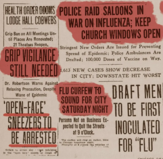
More than 200,000 dead since March. Cities in lockdown. Vaccine trials underway. And a holiday message, of sorts: "See that Thanksgiving celebrations are restricted as much as possible so as to prevent another flare-up." It isn't the message of Thanksgiving 2020. It's the Thanksgiving Day notice that ran in the Omaha World Herald on Nov. 28, 1918, when Americans found themselves in a similar predicament to the millions now grappling with how to celebrate the holiday season amid the coronavirus pandemic. "Every time I hear someone say these are unprecedented times, I say no, no, they're not," said Brittany Hutchinson, assistant curator at the Chicago History Museum. "They did this in 1918." Click here to read more in this USA TODAY article about the eerie similarities between two Thanksgiving observances one hundred and two years apart.
|

In 2020, it's safe to say most of us just experienced a highly unusual Thanksgiving. Between eschewing gathering with family and friends to making do with different dishes due to food supply issues, it has seemed like one of the weirdest holiday seasons to date. But not so long ago, before the nation was grappling with the novel coronavirus, the United States was battling another foe: the Central Powers of World War I. As WWI raged on, Americans experienced five Thanksgivings during wartime before the Treaty of Versailles was signed, meaning that things looked decidedly different at the holiday dinner table. Click here to read more about what Americans were eating for Thanksgiving during WWI, including some eyebrow-raising items.
|
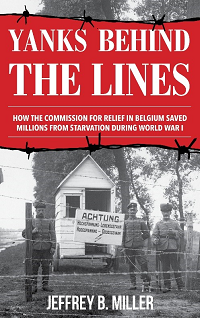
Today, whenever there are civilians anywhere in the world in harm’s way—from a natural disaster to an armed conflict—the nearly universal response has been: “America will help.” That was not the case before World War I (1914–1918). Prior to that horrific conflict—and long before US aid programs such as the Marshall Plan, the Berlin Airlift, and the Food for Peace program—America was better known as a nation of shopkeepers more interested in the bottom line than in saving strangers in need. Author Jeffery Miller explores what helped alter that view: the American-led, nongovernmental CRB, which, working with its Belgian counterpart, the Comité National de Secours et d’Alimentation, helped save from starvation nearly ten million Belgian and northern French civilians trapped behind German lines during the four years of World War I, making it the largest food relief program the world had ever seen. Click here to learn more about how the CRB began the redefinition of how the world saw America, how America perceived its role in the world, and how worldwide humanitarian aid would be administrated in the future.
|
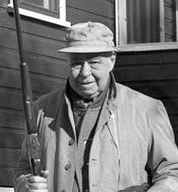
Handwritten by Belgian school girls caught in the middle of an adult clash, the letters from 1915 are frank and brimming with gratitude. Germany had invaded their country, British allies mounted a blockade to starve out the German soldiers, and millions of innocent Belgians faced starvation at the outset of World War I. A traveling exhibit of these translated letters — “When Minnesota Fed the Children of Europe” — visited the Mall of America in Minneapolis in October. The girls’ letters were written generally to their American peers, but two unlikely men with Midwestern ties were pivotal players behind the massive relief effort that helped feed 150 million Europeans a century ago, from 1914 to 1923. Click here to read about the two men, one very well-known, the other known better now for his post-war business legacy that is still in operation today.
|

In May 2020, in the midst of the COVID-19 pandemic, TAPinto Plainfield published an article announcing the Drake House Museum's online exhibit entitled “Plainfield During WWI and the Influenza Pandemic.” That article, it turned out, would connect the past to the present. Leanne Manna, a Trustee at the Drake House, curated the exhibit and posted it online. Rutgers University Intern Stephanie Quartsin and Nancy Piwowar helped to research and document the veterans. The article included the name of one casualty, Martin J. Kane, and a relative of his, who lives Ireland, found the article about the online exhibit. Click here to read more about how a family’s inquiry was answered, and the pieces of a puzzle over 100 years in the making were fitted together.
|
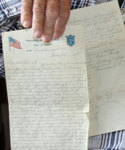
A century-old letter written by a Nobles County, Minn., World War I veteran is in the hands of his granddaughter, thanks to a casual conversation among distant cousins at a family gathering. Henry Slater penned a letter home to his Wilmont, Minn., family on June 15, 1918, from somewhere in France. That the letter is now in the hands of Slater’s son, Jim, and granddaughter, Barb (Slater) Froiland, is a story in itself. Click here to read more and learn how this letter home from the Great War has now found its way home again.
|
As Doughboy MIA wraps up their year and prepares for some big doings in 2021, we would like to repeat a story from November 2019 that hits close to home for us.
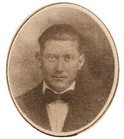
A man is only missing if he is forgotten.
Our Doughboy MIA this month is PVT Franklin Ellenberger - and has a special story!
Born on 12 July, 1892, Frank Ellenberger was from Wilmington, Ohio and was drafted into the army on 27 May, 1918. Sent to Camp Beauregard at Alexandria, Louisiana he was assigned training with the 41st Company, 159th Depot Brigade for indoctrination before being sent to Company I, 153rd Infantry Regiment, 39th 'Delta' Division. The 39th left for France on 6 August, 1918 and once Over There was re-designated as the 5th Depot Division (replacement division). From there, Ellenberger was sent to Company K, 128th Infantry, 32nd 'Red Arrow' Division in September, 1918. When the 32nd went forward to relieve the 91st Division during the Meuse-Argonne campaign on 4 October, 1918 PVT Ellenberger was among them.
The 32nd would be the first division to crack the Kriemhilde Stellung six days later, on 10 October, 1918, but by that time Ellenberger was already dead. A statement by his sergeant says he "saw Private Ellenberger killed instantly by fragments from a high explosive shell. Hit in the head... on October 7th, 1918 while in action near Epinonville." At the time Ellenberger's battalion (the 3rd) was supporting attacks made by the 125th Infantry south of Romagne sous Montfaucon who would, within a few days, capture the ground that the Meuse-Argonne American Cemetery occupies today.
|
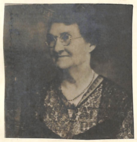
No record of his burial ever made it back to the Graves Registration Service however, and while two separate searches were made for him following the war, nothing further was ever found concerning his case and it was closed in December, 1919. His mother, Laura Ellenberger (right) made the Gold Star Mother's Pilgrimage to see her sons name on the Tablet of the Missing at the Meuse-Argonne Cemetery in 1931.
|
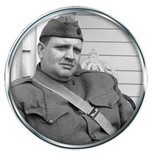
Then, on the evening of 4 November, 2019, our Assistant Field Manager here at Doughboy MIA, Mr Jeremy Wayne Bowles (at left, and popularly known as 'The Dayton Doughboy') was doing some research into Ohio soldiers that served in the war with his family's help when his mother happened to notice a name that rang a bell with her... Ellenberger. Later that night, just on a hunch, she pulled out the family tree to check that name and found an entry for a Private Franklin Ellenberger KIA in the war, who had been her great grandmother's brother. Jeremy checked the ABMC website to find out if this relative of his - whom he had not known about before - was buried in France or had come home, and found that he was MIA!
|
Infer what you want about this story, but it certainly would seem some sort of intervention was at work here for a worker with Doughboy MIA to discover through accident and hunch that HE was related to an MIA from that war - another example that a man is only missing if he is forgotten!
Can you spare just ten dollars? Give 'Ten For Them' to Doughboy MIA and help us make a full accounting of the 4,423 American service personnel still listed as missing in action from WW1. Make your tax deductible donation now, with our thanks.
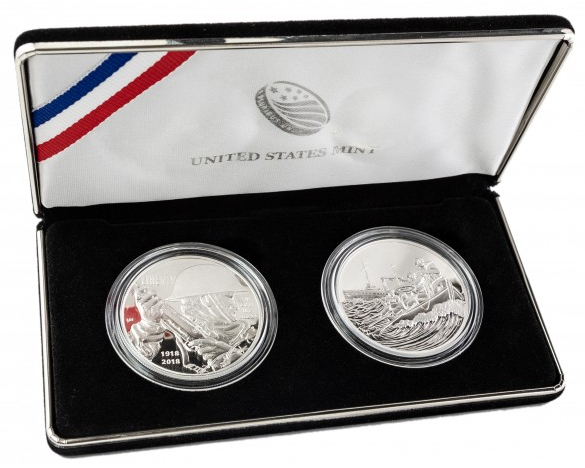
No longer available from the U.S. Mint!
These Official World War I Centennial Silver Dollar Sets are still available here on the WWI Centennial Commission's online gift shop.
NOTE: Each set comes with 2 separate coins. Each set will accompany the Official Doughboy Design alongside your choice of Military Branch.
"The United Mint certifies that this coin is a genuine 2018 World War I Centennial Silver Dollar, minted and issued in accordance with legislation passed by Congress and signed by the President on December 16, 2014, as Public Law 113-212. This coin was minted by the Department of the Treasury, United States Mint, to commemorate the centennial of America's involvement in World War I. This coin is legal tender of the United States."
|